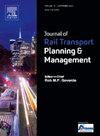A new approach to identify critical causal factors and evaluate intervention strategies for mitigating major railway occurrences in Taiwan
IF 2.7
Q3 TRANSPORTATION
Journal of Rail Transport Planning & Management
Pub Date : 2025-02-14
DOI:10.1016/j.jrtpm.2025.100507
引用次数: 0
Abstract
Following two consecutive catastrophic railway accidents in Taiwan, public safety concern has been raised in railway transportation services. To improve train operation safety, this study integrates the Human Factors Analysis and Classification System (HFACS), Fuzzy Logic Modeling (FLM) method, and Human Factors Intervention Matrix (HFIX) to develop a safety assessment framework. Twenty eight major railway occurrence investigation reports published by the Taiwan Transportation Safety Board are collected for data extraction. Using the HFACS, causal factors causing major railway occurrences are first classified, followed by critical causal factors identification through FLM method. The HFIX is applied to categorized safety recommendations which were issued based on the identified causal factors of occurrence investigations and pair the results with critical causal factors for accident rate evaluations and effectiveness assessment. The evaluations reveal that the statistical accident rate in 2023 was higher than the predicted accident rate. The results also reveal that mitigating the frequency of identified causal factors is more efficient for occurrences reduction than through safety recommendations enforcement. Therefore, decision makers can determine the best intervention strategies based on available resources and develop relevant countermeasures for implementation.
台湾重大铁路事故之关键成因识别及干预策略评估之新方法
在台湾连续发生两起重大铁路事故后,公众对铁路运输服务的安全问题提出了关注。为提高列车运行安全性,本研究将人因分析与分类系统(HFACS)、模糊逻辑建模(FLM)方法和人因干预矩阵(HFIX)相结合,构建列车运行安全评价框架。收集台湾交通安全委员会公布的28份主要铁路事故调查报告,进行数据提取。首先利用HFACS对铁路重大事故的原因因素进行分类,然后通过FLM方法对关键原因因素进行识别。HFIX应用于分类安全建议,这些建议是根据确定的事故调查的因果因素发布的,并将结果与事故率评估和有效性评估的关键因果因素配对。评估结果表明,2023年的统计事故率高于预测事故率。结果还表明,减少已确定的因果因素的频率比通过执行安全建议更有效地减少事故发生。因此,决策者可以根据现有资源确定最佳干预策略,并制定相应的实施对策。
本文章由计算机程序翻译,如有差异,请以英文原文为准。
求助全文
约1分钟内获得全文
求助全文
来源期刊

Journal of Rail Transport Planning & Management
TRANSPORTATION-
CiteScore
7.10
自引率
8.10%
发文量
41
 求助内容:
求助内容: 应助结果提醒方式:
应助结果提醒方式:


